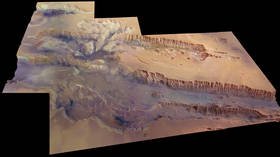Hidden water reserves discovered on Mars

A joint European Union and Russian mission has discovered “significant amounts of water” lying just below the surface of Mars – and scientists say it could be “easily exploitable” by future explorers.
The largest canyon in our Solar System, Valles Marineris sits just south of Mars’ equator and is some 10 times longer and five times deeper than Earth’s Grand Canyon. It’s also hiding a body of water the size of the Netherlands, the European Space Agency (ESA) announced on Wednesday.
The water was detected by the ExoMars Trace Gas Orbiter, a joint project of the ESA and the Russian space agency, Roscosmos. The satellite detected a large amount of hydrogen less than a meter below the canyon’s surface, and, as hydrogen molecules bind into water molecules, the discovery indicates the soil in that location is rich in moisture, which probably exists as ice.
Breaking news: I've spotted hidden #water – either ice or water-rich minerals 🤔 – in #Mars’ Grand Canyon! ❄️💧🔴The reservoir is large, not too deep below ground, & could be easily exploitable for future explorers 🤩Read on: https://t.co/lIAEuz2tNW#ExploreFarther#ExoMarspic.twitter.com/j1jwSCJebq
— ExoMars orbiter (@ESA_TGO) December 15, 2021
“We found a central part of Valles Marineris to be packed full of water – far more water than we expected,” Alexey Malakhov of the Space Research Institute of the Russian Academy of Sciences wrote. “This is very much like Earth’s permafrost regions, where water ice permanently persists under dry soil because of the constant low temperatures.”
The ESA press release noted that water ice usually evaporates in this region of Mars due to the temperature and pressure conditions near the planet’s equator. The fact that this Netherlands-sized body of water hasn’t suggests either a previously unknown mix of atmospheric conditions or that the water is somehow being replenished.
The discovery isn’t the first sign of water on Mars. Ice caps cover its polar regions, and previous ESA missions have found potential water stores several kilometers beneath its surface. However, the latest find reveals water the ESA says is much more “exploitable,” and makes “Valles Marineris an even more promising target for future human exploration missions to the planet.”
The Trace Gas Orbiter launched in 2016 and began orbiting Mars two years later. The project was originally planned as a collaboration between the ESA and NASA, but the Europeans partnered with Roscosmos in 2012, after US President Barack Obama slashed NASA’s budget. The orbiter will be joined in 2022 by a European rover and a Russian surface platform, as the hunt for past life on the Red Planet continues.















